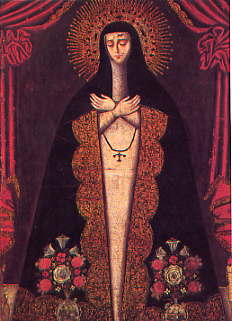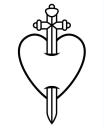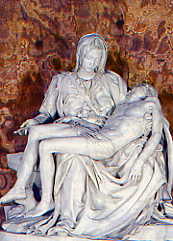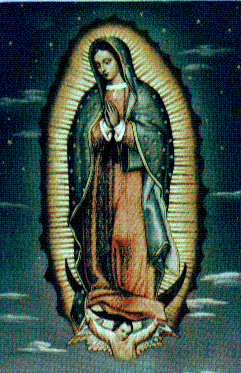Mary As Goddess:Our Lady of Sorrows
|

Señora de los Dolores
Peruvian 18th Century
Private Collection, Venice
|
That will call me blessed,
call me
Also Mother of Tears, and weep with me . . .
–Marie L. Weldon
Queen of All Hearts
March/April 1954
|
O Queen of our grief and our pain thou art,
For their deepest swords have pierced thy heart,
And in Sorrow’s day we should turn to thee
At the foot of the Cross on Calvary.
–Cyril Robert
Our Lady’s Praise in Poetry
|

|
Our Lady of Sorrows
Mary has been worshiped as Our Lady of Sorrows since or before the 3rd Century although the Catholic Church did not formalize this as one of Mary’s titles until the 14th Century. The Church has formally recognized The Seven Sorrows of Mary as:
1. The prophecy of Simeon that her heart would be pierced with swords (Luke 2:34-35);
2. The Flight into Egypt when her infant son’s life was threatened by Herod (Matthew 2:13-21);
3. The Loss of Jesus for Three Days when he was a twelve-year-old boy (Luke 2:41-50);
4. Jesus’ Ascent to Calvary bearing the cross (John 19:17);
5. The Crucifixion and Death of Jesus (John 19:18-30);
6. Jesus Taken Down from the Cross (John 19:39-40);
7. Jesus Laid in the Tomb (John 19:39-42).
| The Feast Day of Our Lady of Sorrows is September 15.
Mother Mary cradling the broken body of her son, as we see in Michaelangelo’s
Pieta pictured here, embodies the mourning many Goddesses have felt for their lost spouses: so Isis wept for Osirus and Innana lamented for Dumuzi. (See Bride.)
The Pieta also embodies the deep sorrow we feel for the loss of a spouse, child, parent, or friend. Throughout the ages, around the world, people (especially women) have sought divine comfort from sharing their sorrows with Mary and identifying their sorrow with hers.
|

Pieta
|

|
Here is what Megan McKenna has to say about Mary in Mary:
Shadow of Grace:
“Mary is the woman butchered in Rwanda, the Muslim woman raped and brutalized and left pregnant by soldiers, the single mother on welfare, working at subsistence wages, raising her children without help from the church or community or her ex-husband. She is all the women, one third of the world’s population always on the move, fleeing from starvation, war, and disasters of flood, earthquake, and draught. She is the woman who mourns the slaughter of the children, the executions of the state, the torture and disappearances of men and women. She is the shadow of the old ones battered or shunted aside, institutionalized or left on the streets to wander and scavenge for a living. . . . She is the one who belongs to those who have no one else. She is the one who mourns injustice, violence, insensitivity, and selfishness. She is both victim and advocate. She is singer and crier for an end to evils and unnecessary hurt (p.4).” |
Also see
Black Madonna
Visit My
Bookstore
Back To Main Page
|




